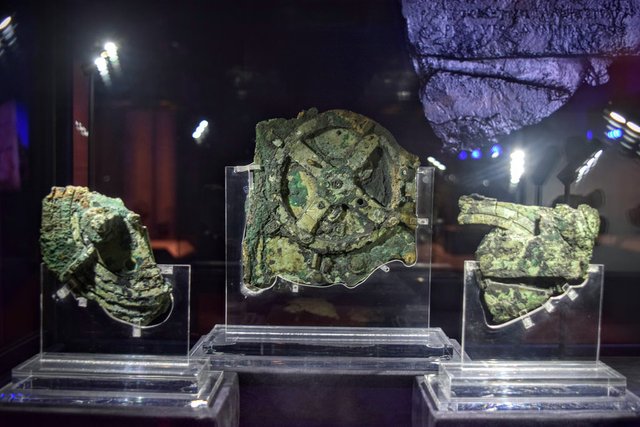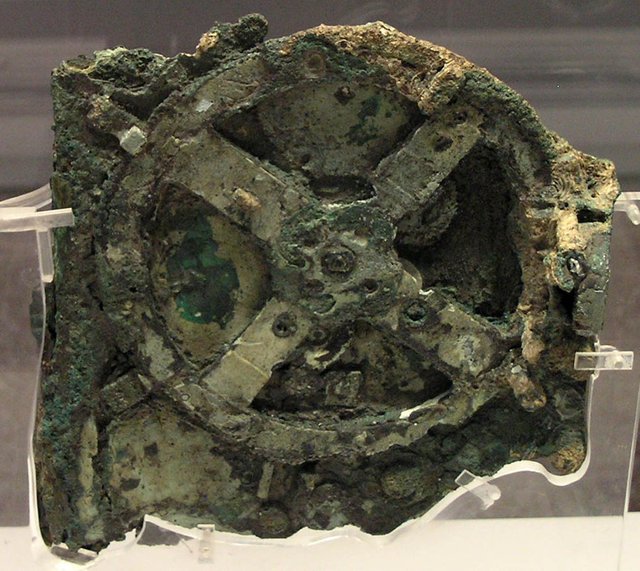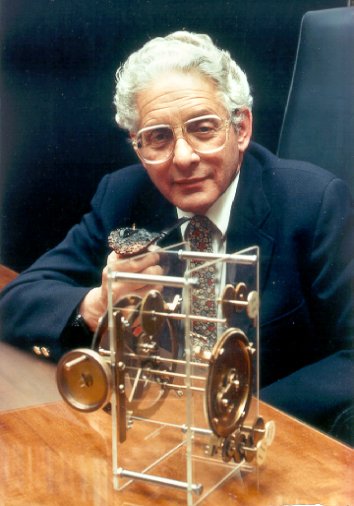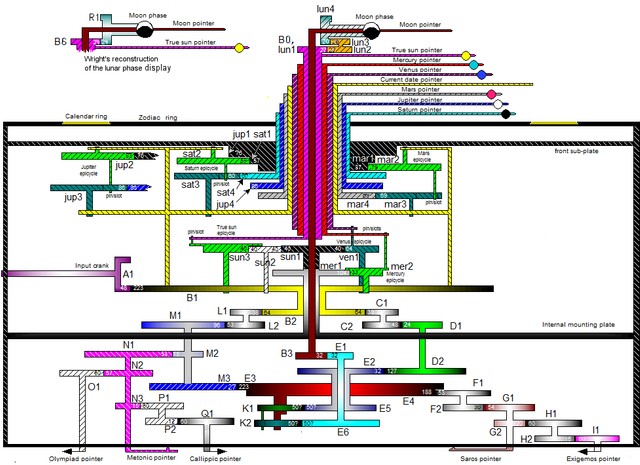The Amazing 2000 Year Old Computer
The Antikythera Mechanism shouldn't exist according to our common understanding of human history. It is a device so complex and masterfully crafted that scientists have been scratching their heads for a century, before coming to a full understanding of this amazing piece of technology, crafted more than 2000 years ago.

Antikythera Mechanism
image by Weekend Wayfarers - source: flickr
You all know by now how much I like science and scientific discovery. Well, the story about this Antikythera Mechanism is a shining example of scientific discovery. Found in 1900, it took several teams of scientists and engineers a century to fully decode the working and function of the device... Ancient Greek scientists planted this great scientific puzzle for modern scientists to solve in their own road to discovery. It doesn't get any better that that as far as I'm concerned! Even until this day, the device is still giving away it's secrets. Or at least until 2015 when the Smithsonian published Decoding the Antikythera Mechanism, the First Computer:
It wasn’t until 2006 that the Antikythera mechanism captured broader attention. That year, Mike Edmunds of Cardiff University in Wales and his team published CT scans of the fragments, revealing more details of the inner workings, as well as hidden inscriptions—and triggering a burst of scholarly research.

The Antikythera mechanism (Fragment A – front)
source: Wikipedia
After dating other artifacts, mainly the coins, the pots and vases, it was established that the treasure had been lying in the seafloor for more than 2000 years; the ship sunk between 70 and 50 B.C. In 1902 the museum curators from the museum of Athens were still opening up boxes from the find and they discovered the fragments of our ancient device. They could see that it contained gears, like some sort of clockwork, something thought to have been done for the first time in the middle-ages by monks in Europe: this device was 1000 years ahead of it's time! They thought it strange, but essentially ignored it.

Derek de Solla Price
Like all cultures, the ancient Greek peered at the sky and the heavenly bodies to keep track of their earthly lives. They kept track of the moon and the sun and it's path through the 12 signs of the zodiac in one full year. To fully appreciate the complexity of the puzzle the maker of the Antikythera Mechanism was trying to solve, you need to understand that the ancient Greek saw earth as being static at the center of the universe, with everything else revolving around it. In their model the sun and the moon both revolved around the earth, the stars and zodiac signs were an almost static, slowly moving background and then there were these strange "wanderers", as the Greek word "planet" translates to "wanderer" or "drifter".
The planets, the ones they could see with the naked eye, behaved erratically: everything revolves around the earth in one smooth direction, but these wanderers sometimes stopped, moved in the opposite direction for a while, stopped again to eventually resume the direction all other heavenly bodies adhered to. Also keeping track of months isn't as straightforward as you'd think. There's the tropical month of 27 days, which is simply one full rotation of the moon around the earth. But, it takes 29.5 days, the synodic month to go from one to the next full moon, because the earth and moon also rotate around the sun together (which the ancient Greek didn't know about); the moon needs those 2.5 days extra to "catch up" with the location of the sun. And 12 times 29,5 days amounts to a year that's 11 days too short, so these scientists from old had to reconcile the lunar time-frames with the solar time frame to assemble one coherent calendar for the year that incorporates both.
The Greek astronomer Meton from the 5th century B.C. discovered that it took 19 solar years for the sun and moon to come back to the same position in the sky relative to one another, and in the same zodiac sign. This is now called the Metonic cycle and this gives us the numbers 235 and 127 that Price found on one of the big gears. Because in 19 solar years we count 254 tropical months and almost exactly 235 synodic months. To keep track of synodic months you'd need another big gear with 254 teeth, or... you divide that by two to get 127 teeth and use another small gear to double it's effect. Imagine a large gear with 235 teeth and a small gear with 19 teeth driving each other, then 19 rotations of the large gear amounts to 235 rotations of the small one; that's how gears can do the mathematics.

A hypothetical schematic representation of the gearing of the Antikythera Mechanism
source: Wikipedia
If you could incorporate this Metonic cycle of 19 years in a timekeeping device, it would stay accurate over long periods of time without the need to constantly adjust the number of months in each individual year. It started to look like a device used to keep track of the movement of celestial bodies, especially the sun and moon. The phases of the moon were essential to ancient Greek's culture as they were used to time the day debts were due and when ceremonies and festivals were to be held. And further investigations of the Antikythera Mechanism revealed that even the phase of the moon was displayed on the device. It was indeed a miniature planetarium or astrolabe.
But... this was just the tip of the iceberg; although Price's work was essential to get this ball rolling, it wasn't until 2006 that significant advancements were made in deciphering this analogue computer by a team led by Mike Edmunds, who heads the Antikythera Mechanism Research Project. Two very important members of this team are Michael T. Wright, who made the best and most complete replica of the original device, and mathematician Tony Freeth who solved again many of the mathematical problems that were already solved by the ancient Greeks.
Tony Freeth was also the one who had the idea to make use of microfocus X-ray and digital imaging to further refine or knowledge about the device:
During 2000 he was inspired by Mike Edmunds to research and develop a film project about the Antikythera Mechanism. In doing this, he realized that much of the classic academic work on the Mechanism is wrong. This led to two research papers in Mediterranean Archaeology & Archaeometry. The first of these challenged the classic research on the Mechanism and proposed new investigations using the latest cutting-edge technologies of microfocus X-ray and digital imaging.
source: The Antikythera Mechanism Research Project
.jpg)
Antikythera mechanism right sideview (transparant model)
source: Wikimedia Commons
The machine needed to make the 3D digital images was an eight ton booth, and since the ancient remains were too fragile to move over large distances, the eight ton imaging device was transported to Athens to do the job! It was worth it though. The team was now able to give Michael T. Wright all the information he needed to make a 1:1 replica of this stunning piece of technology. They discovered that the mechanism also kept track of the 5 visible planets, including their erratic behavior I described earlier, so when you turn the one and only lever or knob, the sun-dial always goes in the same direction, but the dials for Mercury, Venus, Mars, Jupiter and Saturn, periodically start moving in the opposite direction, all rotating around the earth represented by a bronze embossed circle at the center.
Even the fact that the movement of the moon around the earth isn't a perfect circle, but an ellips, is incorporated in the device. The elliptic shape of the moon's orbit causes it to move slower across the sky when further away and faster when nearer; this was replicated in the device by the use of two gears with the same number of teeth, with one of them having a slightly offset center with a pin that slots in the one with the normal center, which causes the rotation speed of another gear to vary according to the position of the pin.
The final product is a machine of immense precision: over a period of 500 years the position of the moon is 1% off. It predicts all solar and lunar eclipses and even shows the direction from which the shadow is cast and the color of the lunar eclipses; sometimes a lunar eclips is just dark, but sometimes it has a fiery red glow. A lot of this information we've gained through the use of advanced surface-imaging techniques. This now more than a century long path of discovery, solving the puzzle of ancient science through modern science is a tribute to science itself, that's why this device has had my attention for more than a decade now.
There's a lot more to say about the device itself and the road to it's full understanding. For example that the ancient Greeks used a lot of Babylonian astronomy and mathematics in their calculations. The fact that it also had a 4 year cycle to keep track of the Olympic Games. A miniature half black, half white ball to show the moon-phase, that it held lunar calendar notations used in several different Greek city-states... If your curiosity is tickled by this article, please watch the documentary below:
2,000 Year Old Computer - Decoding the Antikythera Mechanism
The Greeks used Babylonian science to make a machine to predict future eclipses as they gave them the number 223, another gear that kept track of the 223 lunar months that separate two sequential eclipses; on one of the faces encryptions were found that indicate solar- and lunar eclipses and even the hour of the day it would occur! All in all, this is an epic scientific adventure spanning several thousands of years, just the thing for yours truly to sink his teeth in. I hope you share my amazement and awe regarding this history and the device itself.
That's it for today, my Steemian friends. Thanks, as always, for stopping by and showing interest for my posts; you all make this extra fun to do :-) Please feel free to comment and discuss below; I hope to see you again tomorrow!

Recent articles you might be interested in:
| Latest article >>>>>>>>>>> | Mad As Hell!! |
|---|---|
| Aliens On Earth | Self-Help |
| Myths Of Our Economy: The Middle Class | Early Signs Of Fascism |
| Investigative Journalism To Keep Us Awake | Is Star Wars Dead? |

Thanks for stopping by and reading. If you really liked this content, if you disagree (or if you do agree), please leave a comment. Of course, upvotes, follows, resteems are all greatly appreciated, but nothing brings me and you more growth than sharing our ideas. It's what Steemit is made for!


Just for Full Disclosure, I'm invested in these crypto-currencies:
Bitcoin | Litecoin | EOS | OmiseGo | FunFair | KIN | Pillar | DENT | Polymath | XDCE | 0x | Decred | Ethereum | Carmel | XYO
Ancient civilizations were so much developed into science.I think there was a break point where all these great discoveries lost and we have to start from the beginning.Now we are founding all the secrets of those golden era
When christianity took over many temples of the old gods were burnt to the ground and thats where a lot of scripts were held
The dogmatic scholarship system definitely didn't help either
There is no connection between ancestral science and religion don't mix them
The library in Alexandria was burnt down by early christians that was a lot of ancient knowledge lost forever
You have my gratitude for wandering into my corner of Steemit, @eddard! :-) And you're so right to: not only in the name of Christianity but in the name of a lot of religions a lot of minds and knowledge have been destroyed throughout the ages. It's scary to think about sometimes: in the middle-ages when the Catholic rained supreme in Europe, it was particularly bad. Witch-hunts, public burnings and beheadings, thumbscrews, and a lot more super-cruel punishments were used in the name of the Church. Normally people don't feel the need to make a stranger suffer; only when organized under some sort of religion or ideology this ugly deformed group-mentality takes over, and suddenly we take our children to public executions as if it were a day out.
The burning of all that knowledge in Alexandria is probably the blackest page in the history of science...
I also believe that, on several occasions, humanity has been set back in development. In this particular case it looks like the Romans deliberately destroyed a lot of Greek knowledge and technology. But also Christianity has destroyed a lot, because the Greek were "pagans".
But in this particular case I suspect the Romans were the ones who wanted to wipe out the existence or identity of the Greek civilization; who hasn't heard the story of the Roman centurion who stabbed an old man drawing circles in the sand after he didn't immediately obeyed his commands: that old man was Archimedes according to contemporary Greek writers...
Another explanation of why we can't find more evidence of the advanced technology is the material they used: bronze corrodes real easy real fast.
But there are more archaeological finds that we can't place in time or still don't know the meaning of. What about all these megalithic buildings we wouldn't even be able to build today? Some of the ancient structures we find are just unbelievable; maybe I'll do a post on that to sometime :-)
Thanks for stopping by once again, @dpalash124, I really appreciate that!
I was reading about new finds on the understanding of stonehedge the other day apparently it fullfiled the same function as the device you wrote about a bit like a comparison between a computer from the 70'S and a modern microprocessor :)
Thanks for making me feel welcome here I'll pop in more often :)
Thank you @zyx066